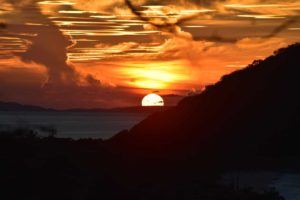(Photo Caption: Seismologist Dr. Carlos I. Huerta-Lopez of PRSMP monitors data being received from strong motion sensors.)
The seismic monitoring network in the British Virgin Islands (BVI) has been
upgraded by the Puerto Rico Strong Motion Programme (PRSMP) at the University of
Puerto Rico – Mayaguez (UPRM).
A team of seismologists from PRSMP visited the BVI last week to undertake the
upgrade of the network which includes close to 30 strong motion sensors placed
at strategic locations around the Territory.
PRSMP team member, Dr. Carlos I. Huerta-Lopez explained that the upgrade
allows for real-time monitoring of the data being transmitted by the sensors.
Dr. Huerta-Lopez, who is also a Professor and Researcher at UPRM, was
responsible for setting up the computer perimeters that will allow the system to
receive continuous signals from the sensors.
With the remote monitoring that the upgraded system affords, seismologists at
PRSMP can track strong motions in the BVI and their location which in turn can
guide future development and planning activities.
“The strong motion network is more focused on recording and estimating the
ground motions which are very important for the society in terms of
construction. It is not our responsibility to locate and monitor earthquakes;
that is done by the Puerto Rico Seismic Network. We focus primarily on general
strong motions at the sites where the stations are deployed,” Dr. Huerta-Lopez
explained.
He added, “right now with the technology we have available, we can do studies
based on the strong motion data collected to determine how a particular site
will respond when an earthquake occurs. Some sites may be in soft soil, others
in rocky soil; these factors will make a big difference in how the site
responds.”
The Puerto Rico based seismologist further explained the benefits of
continuous monitoring. “If the stations are stand-alone or autonomous, you do
not know what is happening there; you will have to visit the site, open the
recorder and then access the data. You may very well find that the data was not
recorded. With continuous monitoring, we are able to detect immediately if a
monitor goes offline and take immediate steps to rectify the problem,” he
stated.
Logistically, the network is quite difficult to coordinate and the
instruments needed are very expensive but the assistance provided is indicative
of the collaboration and the relationship established between PRSMP and the BVI.
“Deploying this kind of instruments is not an easy task, nor is it cheap. They
are very high-tech and the computers and instruments are very rugged as they
need to be able to operate in extreme conditions. You also have to ensure access
to the internet at the site, you have to provide power and you have to provide
security to ensure that the stations are not vandalised,” the seismologist
explained.
Director of Disaster Management, Ms. Sharleen DaBreo welcomed the ongoing
collaboration with PRSMP saying such assistance is invaluable. “To establish and
maintain an independent seismic network would be quite difficult for the BVI to
achieve. We are located in a seismically active zone and are therefore
susceptible to earthquakes, which makes the support provided by PRSMP
indispensable,” she said adding, “We are immensely grateful because it enables
the DDM to provide a more cohesive and all-encompassing programme of disaster
mitigation for the BVI. We are also very grateful to the Department of
Information Technology which provided the local support needed to bring the
network fully online.”
The seismic monitoring system was installed last year and Dr. Huerta-Lopez
said PRSMP will consider the possibility of deploying additional strong motion
sensors to provide coverage in areas that are currently not monitored. The
University of Puerto Rico – Mayaguez has been in partnership with the DDM since
the late 1980s when the first seismic station was established on Anegada. In
1999, a formal agreement was signed with the University to provide earthquake
and strong motion monitoring for the BVI.



